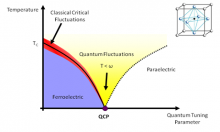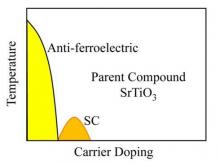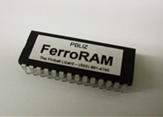 The simplest ferroelectric materials turn out to provide a 'text-book' example of quantum criticality in the solid state. Ferroelectrics are materials that when cooled below their phase transition temperature Tc, undergo breaking of lattice inversion symmetry and spontaneously develop a macroscopic polarization. Pressure can be used as a 'quantum tuning parameter', as shown in the first figure, to suppress Tc towards absolute zero. In the region where the temperature scale is much less than the Debye temperature of the lowest transverse-optic soft mode, quantum rather than classical statistical mechanics are required to understand the observed behaviour. In this (yellow) region, order-parameter fluctuations are typically found to exist in a four-dimensional space and the lattice is observed to fluctuate in a wildly unconventional form.
The simplest ferroelectric materials turn out to provide a 'text-book' example of quantum criticality in the solid state. Ferroelectrics are materials that when cooled below their phase transition temperature Tc, undergo breaking of lattice inversion symmetry and spontaneously develop a macroscopic polarization. Pressure can be used as a 'quantum tuning parameter', as shown in the first figure, to suppress Tc towards absolute zero. In the region where the temperature scale is much less than the Debye temperature of the lowest transverse-optic soft mode, quantum rather than classical statistical mechanics are required to understand the observed behaviour. In this (yellow) region, order-parameter fluctuations are typically found to exist in a four-dimensional space and the lattice is observed to fluctuate in a wildly unconventional form.
 Going beyond the simplest ferroelectric materials can lead to a much more complex picture. Coupling of the critical ferroelectric modes to other degrees of freedom such as magnetic excitations, delocalised electrons or other phonon branches is expected to give rise to a rich phase diagram of physical phenomena. This has motivated our research in for example, multiferroic materials and ferroelectric metals. Evidence in fact exists for superconductivity on the boundary of a ferroelectric state in a number of materials, as exemplified by the second figure shown, where one expects the ferroelectric polarization waves to interact with the electron liquid.
Going beyond the simplest ferroelectric materials can lead to a much more complex picture. Coupling of the critical ferroelectric modes to other degrees of freedom such as magnetic excitations, delocalised electrons or other phonon branches is expected to give rise to a rich phase diagram of physical phenomena. This has motivated our research in for example, multiferroic materials and ferroelectric metals. Evidence in fact exists for superconductivity on the boundary of a ferroelectric state in a number of materials, as exemplified by the second figure shown, where one expects the ferroelectric polarization waves to interact with the electron liquid.
 Technological applications of quantum ferroelectric materials include novel cooling systems, energy storage units, sensing devices and computer memory.
Technological applications of quantum ferroelectric materials include novel cooling systems, energy storage units, sensing devices and computer memory.
